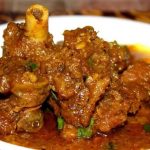 When alive and flouncing through your dreams, sheep are called sheep, but when brought to your table in a mushroom sauce the same creature is called mutton, a word that English derived in the late thirteenth century from the Old French moton, meaning sheep. French in turn acquired this word from a Celtic source such as the Old Irish molt, the Breton mols, or the Welsh mollt. It is also possible, though not certain, that even further back in history the common source of these Celtic names for sheep was the Latin mutilare, meaning to cut off: after all, mutton is not the meat of any old sheep, but specifically of those that have been castrated. If mutilare is the source of mutton, then the name of the meat literally means mutilated, since that word is the direct descendent of the Latin mutilare.
When alive and flouncing through your dreams, sheep are called sheep, but when brought to your table in a mushroom sauce the same creature is called mutton, a word that English derived in the late thirteenth century from the Old French moton, meaning sheep. French in turn acquired this word from a Celtic source such as the Old Irish molt, the Breton mols, or the Welsh mollt. It is also possible, though not certain, that even further back in history the common source of these Celtic names for sheep was the Latin mutilare, meaning to cut off: after all, mutton is not the meat of any old sheep, but specifically of those that have been castrated. If mutilare is the source of mutton, then the name of the meat literally means mutilated, since that word is the direct descendent of the Latin mutilare.
Meat from mature sheep.
The edible tissue of a sheep that has reached twelve months of age or beyond. The finest mutton is referred to as “yearling,” originating from sheep that are between one and two years old.
Mutton refers to the meat obtained from a fully mature sheep, in contrast to lamb, which comes from an animal under one year old. The highest quality mutton is derived from well-nourished sheep of good breeds, typically aged between 2 to 3 years. To enhance the flavor and tenderness of the meat, it is advisable to hang it in a cool and well-ventilated area for approximately two weeks after the animal has been slaughtered. This aging process allows the meat to develop improved flavor characteristics and tenderness, resulting in a more enjoyable culinary experience.
